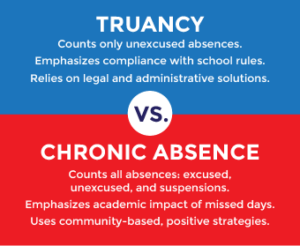
Oregon Has One of the Highest Student Absentee Rates in the Nation
The school year has resumed but not every student will be returning to their classrooms. Data indicates more than one-third of Oregon’s K-12 students miss 10 percent or more school days, the fourth highest rate in the nation.
In a column for The New York Times, David Leonhardt called chronic absenteeism the ‘new normal’ in public schools across America.
The Oregonian recently reported chronic absenteeism has been a problem facing Oregon schools for years, predating school closures during the Covid pandemic. According to the Oregon Department of Education, 20 percent of Oregon K-12 students were chronically absent in 2018, compared to 15 percent in Washington and 12 percent in California. In the 2021-2022 school year, Oregon’s student absentee rate rose to 36.1 percent.
 Data from the 2022-2023 school year won’t be available until next month, but Thomas Dee, a Stanford University graduate education professor who studies school absenteeism, predicts it will remain higher than before the pandemic. “I’m just stunned by the magnitude,” Dee told Leonhardt.
Data from the 2022-2023 school year won’t be available until next month, but Thomas Dee, a Stanford University graduate education professor who studies school absenteeism, predicts it will remain higher than before the pandemic. “I’m just stunned by the magnitude,” Dee told Leonhardt.
Reasons for Chronic Absenteeism
Explanations for chronic absenteeism, according to Dee, include student bullying, depression and lost learning during pandemic school closures. However, Dee says, the best explanation may be that students simply got out of the daily habit of going to school.
“For almost two years, we told families that school can look different and that schoolwork can be accomplished in times outside of the traditional 8-to-3 day,” explains Elmer Roldan, who runs Communities for Los Angeles Student Success (CLASS) coalition. “Families got used to that.”
 Leonhardt expresses sympathy for parents with children who resist returning to school or who let their children remain at home. “I know some readers will wonder whether families are making a rational choice for keeping their children home, given all the problems with schools today: unhealthy early start times for high schools, political fights over curriculum; bullying and vaping; and inequities.”
Leonhardt expresses sympathy for parents with children who resist returning to school or who let their children remain at home. “I know some readers will wonder whether families are making a rational choice for keeping their children home, given all the problems with schools today: unhealthy early start times for high schools, political fights over curriculum; bullying and vaping; and inequities.”
“Chronic absenteeism is a sign schools need help,” Leonhardt concludes. Students who pop in and out of class can contribute to classroom chao and putting more pressure on teachers, he says.
Many school systems are reaching out to parents in an effort to persuade them to send their children back to school. As The Oregonian reported, another approach that was working before the pandemic was to have honest conversations with absentee students.
Rise and Fall of Truancy Courts
A truancy court judge in Brookings coaxed out of a student that he avoided school because he was bullied. The same judge learned another student skipped school to accompany his pregnant girlfriend to doctor appointments and was afraid to tell his parents. These conversations succeeded in reducing truancy in Brookings schools. Then the pandemic hit.
Reducing chronic absenteeism is hard, Dee admits, but he encourages school officials to monitor attendance and reach out immediately to families when students are absent. He believes carefully crafted, personalized messages sent to families can make a “meaningful impact and don’t cost much money”.
 Truancy courts are no longer an option in Oregon after the 2021 legislature passed a bill. Critics claimed truancy court is a “pathway to prison” for young people, especially students of color and from poor families. The Brookings truancy court judge disagreed, noting he issued few fines and mostly helped students, families and school officials work out accommodations that enabled students to return to classrooms.
Truancy courts are no longer an option in Oregon after the 2021 legislature passed a bill. Critics claimed truancy court is a “pathway to prison” for young people, especially students of color and from poor families. The Brookings truancy court judge disagreed, noting he issued few fines and mostly helped students, families and school officials work out accommodations that enabled students to return to classrooms.
The Oregon Education Association, which represents the majority of teachers in Oregon, and the Portland nonprofit Youth Rights and Justice say research shows the way to address student absenteeism is through a “trauma-informed approach”. That involves understanding a student’s background and providing mental health resources and support to help them get back into regular attendance.
Lawmakers in the 2016 and 2017 sessions approved funding and pilot programs to study trauma-informed responses to student absenteeism. Pilot studies were undertaken to assist educators recognize and adopt strategies that stressed engagement and intervention rather than suspension and expulsion.
Trauma-informed training encourages understanding how trauma triggers behavior and impacts learning. Educators are taught to learn what student behavior may be telling them and adjust teaching practices to support students experiencing trauma.
The Oregon Department of Education describes trauma indicators such as difficulty focusing on schoolwork, social isolation and chronic health issues. Trauma-informed responses include recognizing signs of trauma in students, creating physically and psychologically safe spaces, obtaining behavioral health support and avoiding re-traumatizing students.
 Chronic Absenteeism Versus Truancy
Chronic Absenteeism Versus Truancy
According to Dee, only two states – Connecticut and Massachusetts – have found ways to reduce student absenteeism, based on early reporting of their most recent school years.
Connecticut has published an intervention guide for how schools should address chronic absenteeism. The guide says, “Chronic absence and truancy are not interchangeable terms. They describe different aspects of the absenteeism problem and require different approaches.”
“Responses to truancy are usually about school rule compliance and can lead to court intervention,” according to the guide. “Chronic absence, on the other hand, incorporates all absences: excused, unexcused absences, and suspensions and expulsions served. By monitoring chronic absence, the focus is on the academic consequences of lost instructional time and on preventing absences before students fall behind in school. It is an early indicator that a student may fall behind in the classroom.”
Research shows the way to address student absenteeism is through a “trauma-informed approach”.
Consequences of Inaction
Dee, who also is Research Associate at the National Bureau of Economic Research, stresses that fixing the problem of chronic student absenteeism should be a priority. In a paper published this year, Dee says failing to address student absenteeism will threaten academic recovery from the pandemic. As a result, a significant segment of young people will fall behind and despair they ever can catch up.
Dee also published a paper this year titled, Where the Kids Went: Nonpublic Schooling and Demographic Change during the Pandemic Exodus from Public Schools.”




